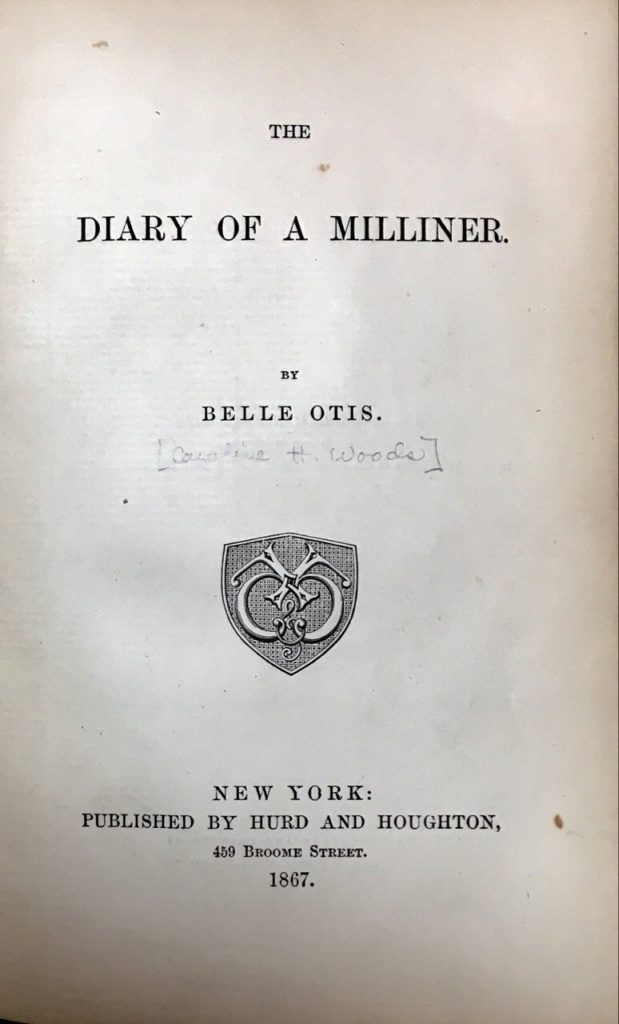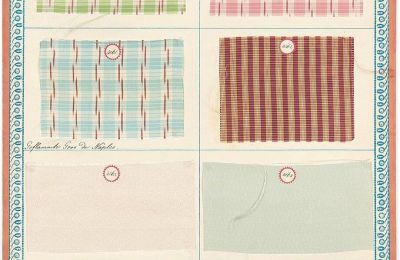1867 erschien das „Diary of a Milliner“, Tagebuch einer Putzmacherin, geschrieben von Belle Otis, dem Pseudonym der Autorin Caroline H. Woods. (Woods, Caroline: Otis, Belle: The Diary of a Milliner. Hurd and Houghten, New York 1867). Woods schrieb unter eigenem Namen ein weiteres Buch über ihre Erfahrungen als Hausmutter (Matron) eines Gefängnisses (Women in Prison. Hurd and Houghten, New York 1869).

Es gibt kaum Information über die Autorin. Eine der wenigen Quellen zu Carolyn Woods zitiere ich daher hier komplett:
Woods, Caroline H., born: circa 1840s; died: death date unknown; Wrote under: Belle Otis
Stimulated by a restless curiosity about human nature, Caroline H. Woods observed, analyzed, and wrote about the people around her. If her two books, Diary of a Milliner (1867) and Woman in Prison (1869), can be accepted as autobiographical (which they claim to be), she opened a millinery shop after her husband died. A few years later her interest in reform led her to take the job of prison matron, which she kept until exhausted by overwork and lack of sleep.
In both books the author seeks to reveal the principles of human nature behind the personalities she meets; everyday encounters are material for generalizations and philosophical musings about her fellow women and men. But to a modern reader, her abstract cogitations are perhaps less interesting than her clear portrayal of her surroundings.
Diary of a Milliner humorously records the manners, eccentricities, and financial rituals of her predominantly middle-and upper-class clients. Her customers include the fussily pretentious woman who tries on every hat in the store without buying one, the „highway shopper“ who custom orders a bonnet and then decides it is not what she wanted after all, the wealthy socialite who needs reassurance that she has purchased the most expensive hat in town, and the bold woman who just wants to „borrow“ a mourning bonnet for a funeral. Woods has a quick-witted answer and apt sales psychology for dealing with every kind of client.
Woman in Prison, however, adopts a more serious tone, concentrating less on exposing the foibles of human nature than the shameful conditions in the women’s section of the state penitentiary. Without condescension, her plain, unpretentious prose captures the personalities, feelings, slang, and behavior of the prisoners. Through the eyes of the new matron, we come to like and respect the inmates more than those in charge of them.
Woods‘ revelations about prison conditions support her assertion that if such institutions were open for public inspection, reform would inevitably follow. The small „stone dens“ where prisoners live resemble the „low, narrow…cages of wild animals,“ where bedbugs, rats and mice, and colonies of insects freely gather. Because the prison master keeps the inmates busy doing contract work (mostly sewing) in the „shop,“ (which brings revenue to the prison’s board of directors), he will not assign anyone to clean the cells. Prisoners also must sew and keep house for the master’s family, while his wife receives a full-time salary as „Head Matron,“ without doing any work.
Other abusive conditions include long hours and minimal food—barely enough to keep the prisoners working. Punishment is arbitrary (inmates are not allowed to talk while working in the shop) and unrelated to the offense. Given the conditions Woods describes in Woman in Prison, one can easily see why she asserts that the prisoners leave the penitentiary more degraded and hardened in crime than when they entered the institution.
While the literary value of Woods‘ writings is slight, her clear rendering of two very different sides of American society will be useful to students of social history and psychology.
Bibliography:
A Critical Dictionary of English Literature and British and American Authors Living and Deceased (1900).
Young, Melanie M.S.: „Woods, Caroline H. .“ American Women Writers: A Critical Reference Guide from Colonial Times to the Present. . Encyclopedia.com. 19 Oct. 2020
Im „Diary“ beschreibt Woods zunächst ihre Motivation, Putzmacherin zu werden. Als Witwe möchte sie unabhängig und nicht auf Mildtätigkeit angewiesen sein. Zunächst schwankt sie noch zwischen einem „fancy-goods“-Laden, Schneiderei, Putzmacherei oder einem Süßigkeitenladen, und entscheidet sich dann für die Putzmacherei mit dem dazugehörigen Ladengeschäft.
Im weiteren Verlauf ihres „Tagebuches“ berichtet Woods von ihrer Arbeit, insbesondere aber von ihren Erlebnissen mit den unterschiedlichsten Kundinnen und Kunden. Dabei reflektiert sie ihre eigenen Gefühle und befragt ihr inneres zweites Ich („the inner dual“), wenn es z.B. um den Versuch der Kundinnen geht, um einen Hut zu feilschen, usw. In humorvoller und auch liebevoller Weise beschreibt sie, wie sie es schafft, auch bei unangenehmer Kundschaft die Geduld nicht zu verlieren und das anstehende Geschäft zu einem guten Ende zu bringen.
En passant werden auch Arbeitsabläufe der Putzmacherei erwähnt, so das Garnieren der Hüte, die Zuarbeiten ihrer Mitarbeiterinnen und die Arbeitsumstände. Eine längere Diskussion mit einer Kundin dreht sich z.B. darum, dass sie ihren „Girls“ nicht mehr als 10 Stunden Arbeit pro Tag zumuten will (sie selbst sei danach auch nicht mehr zu konzentrierter Arbeit in der Lage). Bei einer anderen Kundin geht es um die Ablieferung eines Hutes nach 20:00 Uhr am Samstag (oder Sonntag), und Woods macht klar, dass bei ihr am Samstag nicht mehr als an anderen Tagen und Sonntags gar nicht gearbeitet wird. In diesen kleinen Episoden wird die moralische Haltung der Autorin sichtbar, nämlich mit Angestellten respektvoll und wertschätzend umzugehen, sie nicht auszubeuten usw.; interessant sind hier die offensichtlich anderen Erwartungen der Kundschaft an eine Normalität in der Branche im Jahre 1867.
© Copyright Anno Stockem 2020
Literarische Bearbeitungen der Putzmacherei:
- D’Anspach, Maria: La Modiste. Paris 1841
- Bazin, René: Aus ganzer Seele. Der Roman einer Modistin. Köln o.J.
- Castanié, François: Royales Amours d’une petite Modiste (Madame du Barry). Paris 1913
- De Genlis, Madame de: La marchande de Modes, Comédie. in: Theatre à l’usage des jeunes personnes“ von Madame de Genlis, 4. Band. Paris 1781
- Duncker, Dora: Die Modistin. Novellen und Skizzen. Berlin 1894
- Eichler, Ludwig: Berlin und die Berliner. Die Putzmacherin. Berlin 1841
- Flügge, Heinrich: Der Graf und die Putzmacherin. In: Der Humorist. August 1847
- Hansen, Frieda: Die Lehrzeit der Putzmacherin Frieda Hansen 1929-1932
- Hopkins, William B.: Milliner to a Mouse. A Capital Chat 1903
- Humphreys, Eliza: Vanity – The Confessions of a Court Modiste 1901
- Langlade, Émile: La Marchande de Modes de Marie-Antoinette, Rose Bertin. Albin Michel, Paris o.J. (1911)
- Lauwick, Hervé: L’amour et la modiste. La Renaissance du Livre. Paris 1926
- Lyser, Johann Peter: Die arme häßliche Putzmacherin. In: Der Humorist. Oktober 1847
- Rowcroft, Charles: Fanny the little Milliner or The Rich and the Poor. Smith, Elder & Co., London 1846
- Schlägel, Max: Die Putzmacherinnen. Berlin 1871
- Taffetas, Hester: Recollections of Mrs. Hester Taffetas, Court Milliner and Modiste, during the Reign of King George the third and his Consort Queen Charlotte. Edited by her Granddaughter. 1859
- Thompson, Georg: Käthchen Castleton, die schöne Putzmacherin, oder Die Schicksale eines jungen Mädchens im niederen Lebensstande, die an einem Tage zugleich Frau und Wittwe wurde. C. Holbrook, New York 1853
- Weiße, Christian Felix: Die Putzmacherin, oder: Sieg der Tugend über Vorurtheile. In: Becker, Wilhelm Gottlieb: Erholungen. Berlin 1796
- Woods, Caroline: Otis, Belle: The Diary of a Milliner. Hurd and Houghten, New York 1867
Wenn Ihnen der Beitrag gefallen hat, melden Sie sich gerne zum Newsletter von ansto.de an!


2 thoughts on “Diary of a Milliner – Eine Putzmacherin 1867”